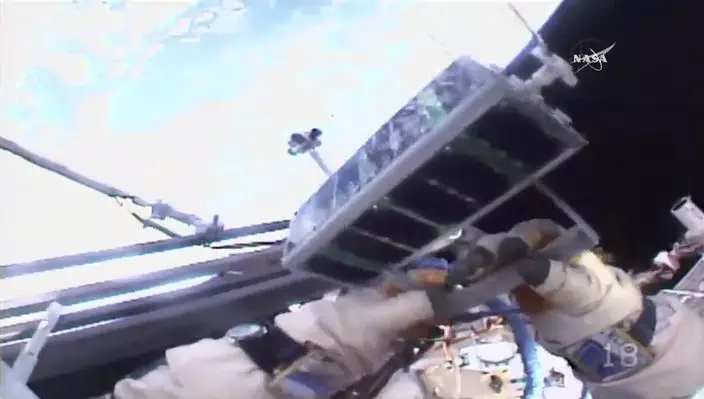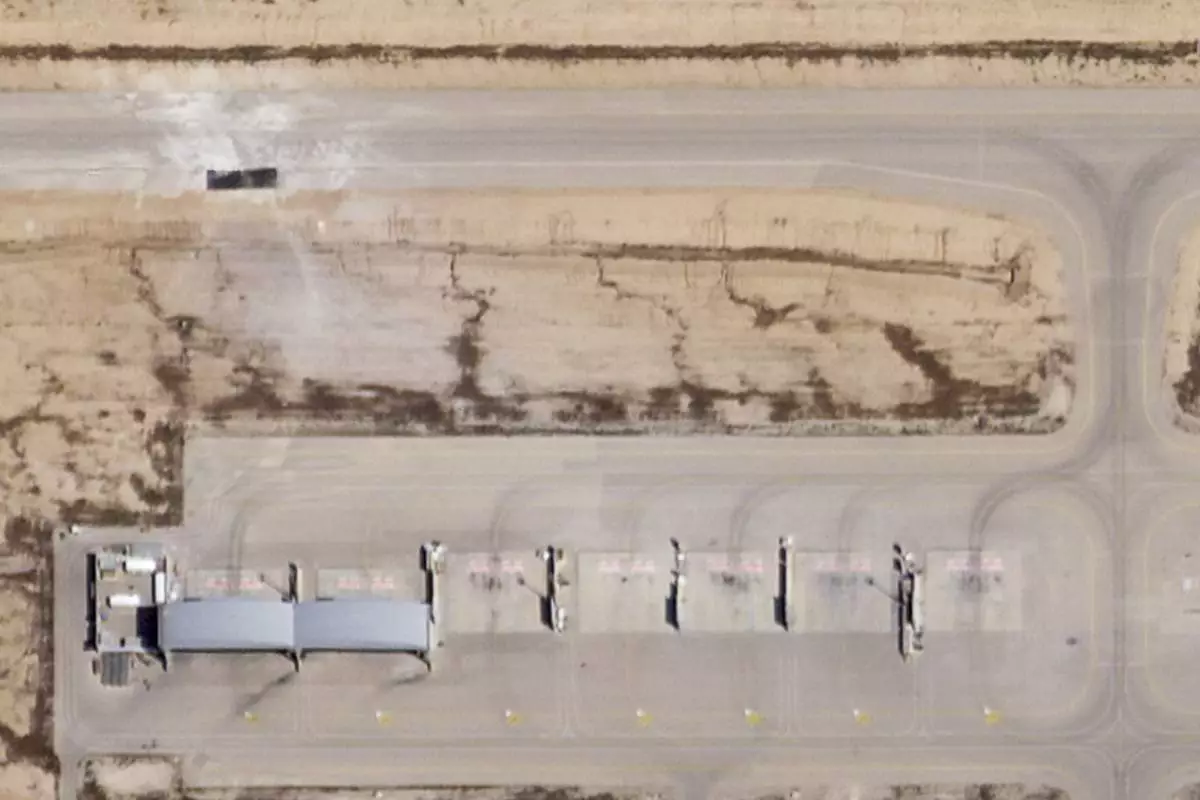Spacewalking cosmonauts set free the world's first satellite made almost entirely with a 3-D printer on Thursday.

In this image made from video provided by NASA, Russian cosmonaut Sergei Ryazansky holds a mini satellite before launching it by hand from the International Space Station on Thursday, Aug. 17, 2017. (NASA via AP)
In total, Russians Fyodor Yurchikhin and Sergey Ryazanskiy ended up releasing five nanosatellites by hand. One by one, the tiny craft — no more than 1 to 2 feet in size — tumbled safely away from the International Space Station.
The exterior casing of the first one tossed overboard was made with a 3-D printer. So were the battery packs inside. Researchers want to see how 3-D-made parts weather the space environment.
The 3-D satellite contains regular electronics. It also holds greetings to planet Earth in a variety of languages, courtesy of students at Siberia's Tomsk Polytechnic University, where the satellite was made.
The other satellites deployed Thursday have traditional spacecraft parts.
Each weighs just 10 to 24 pounds. They're expected to orbit for five to six months.
One commemorates the 60th anniversary of the world's first satellite, Sputnik 1, launched Oct. 4, 1957, by the Soviet Union. Another pays tribute to Russia's father of rocketry, Konstantin Tsiolkovsky. He was born 160 years ago next month.
The remaining two small satellites involve navigation and other experiments.
Yurchikhin and Ryazanskiy completed the satellite releases within an hour of venturing outside. Barely a minute passed between a few of the launches. The rest of their work took longer than expected, however, and Russia's Mission Control outside Moscow sent the planned six-hour spacewalk into overtime. It ended up lasting 7 1/2 hours, and the cosmonauts said their hands were tired. All but one task got done.
"We will have actually some grounds to get drunk today, I think," one of the cosmonauts joked in Russian. A flight controller replied that he'd do it for them.
The cosmonauts collected science experiments from outside their 250-mile-high home, and wiped thruster residue from various surfaces for analysis. Three Americans and one Italian also live on the space station.
DUBAI, United Arab Emirates (AP) — An Iranian attack on an Israeli desert air base last week as part of Tehran's unprecedented assault on the country damaged a taxiway, a satellite image analyzed by The Associated Press on Saturday shows.
The overall damage done to Nevatim air base in southern Israel was minor despite Iran launching hundreds of drones, ballistic missiles and cruise missiles. Israeli air defenses and fighter jets, backed by the U.S., the United Kingdom and neighboring Jordan, shot down the vast majority of the incoming fire.
But the Iranian attack last weekend showed Tehran's willingness to use its vast arsenal of ballistic missiles directly against Israel as tensions remain high across the wider Middle East over the Israel-Hamas war in the Gaza Strip. An apparent Israeli retaliatory attack Friday on Isfahan, Iran, and Tehran's low-key response to it suggest both countries want to dial back their long-running shadow war for now — though risks of a wider conflagration in the region remain.
The Planet Labs PBC image, taken Friday for the AP, shows fresh blacktop across a taxiway near hangars at the southern part of Nevatim air base, about 65 kilometers (40 miles) south of Jerusalem. The daily newspaper Haaretz, which published lower-resolution images of the site Thursday, identified the hangars nearby as housing C-130 cargo aircraft flown by transport squadrons.
The satellite image corresponds to footage earlier released by the Israeli military, which showed construction equipment working on the damaged taxiway. A hangar in the background of the video mirrors those seen nearby.
Other images released by the Israeli military showed a crater in the sand and damage under what appeared to be a wall that it said came from the Iranian attack. The little visible damage seen at the air base in the satellite image directly contradicts Iran's efforts to portray the attack as a great victory to a public alienated by the Islamic Republic's cratering economy and its heavy-handed crackdowns on dissent in recent years.
“This operation became a sign of the power of the Islamic Republic and its armed forces," Iranian President Ebrahim Raisi said Friday. “It also showed the steely determination of our nation and our wise leader, the commander of all forces.”
However, it does show Iran's arsenal has the ability to reach Israel, as the April 13 attack marked the first direct military assault on the country by a foreign nation since Iraqi dictator Saddam Hussein launched Scud missiles at Israel in the 1991 Gulf War.

This still from an undated handout video released by the Israeli military shows workers trying to repair a taxiway at Israel's Nevatim air base. An Iranian attack on an Israeli desert air base as part of Tehran's unprecedented assault on the country damaged a taxiway, a satellite image analyzed by The Associated Press on Saturday shows. (Israeli military via AP)

This satellite photo taken by Planet Labs PBC shows a repaired taxiway after Iranian attack on Israel's Nevatim air base Friday, April 19, 2024. An Iranian attack on an Israeli desert air base as part of Tehran's unprecedented assault on the country damaged a taxiway, a satellite image analyzed by The Associated Press on Saturday shows. (Planet Labs PBC via AP)









